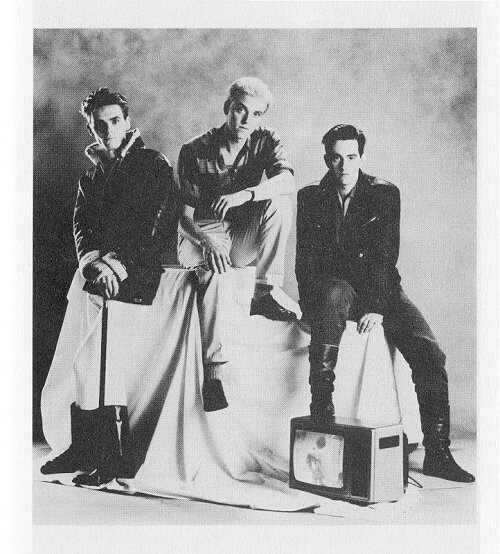THE COMPLETE SYNTHESISER HANDBOOK - Synthesisers in the Studio
Michael Norman and Ben Dickey Zomba Books 1984 ISBN 0946391351
Chapter Six
Synthesisers in the Studio |
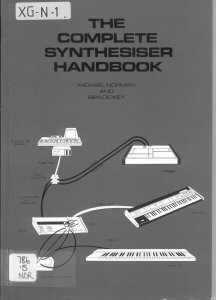 |
| The ability to control the advanced facilities available in a modern
recording studio. relies on a fundamental understanding of the role of each
piece of equipment. When the multitrack tape recorder first came into use,
it was to allow the recording of many instruments, separately and without
loss of quality. It soon became clear, however, that studio recording could
be as important a part of the creative process, as writing or performance.
Studio producers, who once filled the role that Drama producers still do
in the theatre, have become as celebrated as the artists themselves. We have
now moved into the age of the synthesiser and the artistry of the producer
has become even more crucial. In this chapter I will look at the multitrack
studio, and the techniques employed when recording electronic instruments.
At the heart of the recording studio lies the multitrack tape recorder. The sound source can be acoustic, for example the human voice, which is transduced into electrical impulses by a microphone, or purely elect-ronic, as is the case with synthesisers. These signals are recorded onto multitrack tape via the mixing desk while in playback mode, the multitrack tape machine becomes the source, and the signal is routed once again through the desk to the master tape recorder (normally two-track stereo), The former is the recording process the latter the mixdown. During either process, outboard equipment may be patched in and equalisation, levels, etc, adjusted. Most of these functions are controlled from the mixing console. The power of the purely electronic instrument, such as a Drum machine or sequencer, is enhanced by its ability to produce a 'sync' code. The recording of this sync code onto multitrack tape, allows one track to contain all the information necessary to electronically guide the instrument through a composition. The pure untreated sound of the synthesiser, however, is rarely present on the master recording. It is when synthe-sisers are used in conjunction with the vast range of studio effects that they provide unique creative possibilities. The outboard facilities commonly available may be divided into three groups. Those concerned with timbre, the simplest of which is equalisation, with pitch, such as the harmonizer, and finally those concerned with time such as echo, reverb etc. Following the path of ever increasing sound quality, the need arose to contain the dynamic range (the intensity or volume variations of a sound source) within manageable limits. To this end a device known as the Compressor came into use, which can be enrolled by the artist as a creative tool, although their main function is to modify signals from microphone inputs. Compressors are particularly useful when trying to introduce warmth to synthesised bass sounds, and compression para-meters may be changed to introduce many subtle effects into the perceived sound. Noise gates (Expanders) are generally used to reduce unwanted noise, either during recording or mixdown. The gate opens only when a signal is present above a preset threshold level, otherwise the channel is shut off. The action of opening the gate can depend on the level of a second signal, in which case this effectively triggers the passage of the gate input signal for special effects. The ability to change the timbre of a sound has been a familiar aspect of recording technique for some time. One method of adjusting equalisation is to set the gain to maximum, and vary the frequency control until the range of the sound to be affected is found. The amount of gain is then reduced until the desired effect is achieved. A whole new area of control associated with pitch is a more recent development. The Harmonizer allows the pitch of a signal to be moved up or down by a precisely controlled amount (expressed as a ratio). By altering the pitch a few percent and recombining with the original signal the resultant sound of a synthesiser can be made to 'beat' hypnotically. Setting the ratio to give a perfect harmony, a fuller sound can be achieved on synthesiser lead lines and sequences. Now we come to the most frequently used effects whose chief ability it is to provide depth to the sound. These manipulate the signal in time to give reverb, echo and other 'ambient' sounds. Echo, a natural feature of our aural environment, may be controlled in the studio to give any number of repeats at any rate, decaying over any period of time. Although it is not often used in isolation it is frequently the first treatment applied to enlarge the sound. Digital Delay Lines, commonly known as DDLs, have now superseded the echo unit for reasons of higher quali sound and more preciseplacement of the echo. This device encodes the incoming analog signal into digital form and feeds it into; a shift register, reconverting digital to analog after processing. A high frequency oscillator provides clock pulses which cause the register to step from one location to the next at regular time intervals. The delay imposed on the output signal depends on the clock rate and number of locations in the register. By varying the oscillator frequency and the location at which the register outputs the signal, the amount of delay can be controlled. A sequencer may be fed through the DDL to give doubled or tripled echoes moving within the stereo image. In this way the DDL enters key areas of composition. Reverberation is a key parameter in the description of studio environment. Studio designers, by carefully prescribing the absorbing and reflecting surfaces surrounding the sound source, produce the characteristics of live or dead sounds. Unfortunately this is a rather permanent imposition and often leads producers to have favourite studios The facility to create the illusion of natural reverberation and controlling its character, is provided by the Reverb unit or more recently the Digital Reverb Unit. Synthesised sounds being peculiarily dry and unnatural are especially suitable for treatment. Some units simply consist of a spring which is made to vibrate, while the Digital Reverb unit, for example the Quantec Room Simulator, is an immensly versatile piece of equipment capable of'creating'almost any recording environment. Electronic percussive sounds benefit particularly from such treatment. The effect of combining these signal processing devices is often to increase the apparent number of performers, or define the apparent size and acoustics of a performance space, Electronic instruments are not usually associated with a performer in the same way, but the effects can generally be described as giving a fuller sound. Automatic Double Tracking (ADT) is achieved by adding a single short repeat, and chorus effects by small pitch changes using a Harmonizer. The size of a room is gauged by the time taken for the inital sound reflection to return to the listener, after a direct sound is heard. By delaying a signal fed to a Reverb unit the onset of reverberation can be set to give the illusion of a large or small space. This is called Delayed Reverb. Studios should always be regarded as sound workshps, so studio equipment must be played with in order to learn how to make and discover original sounds. Much of an engineer's skill, and that of the producer, come from learning by experience, and you will find that the artists featured in the rest of this book give many clues to the ways of working in a studio. |
|
| Heaven 17 (Martyn Ware, Glenn Gregory and Ian Craig Marsh) provide a
specific example of the way synthesisers are used, not only 414 the recording
studio. but from the commencement of writing a song. I asked Martyn Ware
how they had approached the recording of their new album.
The starting point of all songs was to produce a demo played on a Casiotone and recorded using the onboard digital recording facility. At this point these demos capture the basic chord structure, tempo and feel of the composition. The songs were then transcribed into standard musical notation in preparation for entering the studio proper. As the band had decided to utilise the Fairlight to its full potential as an aid to composition, the next part of the song's development centred on the Fairlight. (See next chapter.) When I visited the band in the studio, they had completed their first week's work on the album. This had been spent exploiting the Fairlight's sampling facilities to the full, storing any interesting sounds, to be recalled at any time as the album progressed. In this way composition elements are built up to provide a database, for the process of getting each song down onto multitrack. The track Temptation from their second album Luxury Gap, is a good example of how Heaven 17 work in the studio, particularly with regard to electronic instrumentation and use of sync codes. The process may be followed by examining the track sheets, right up to the point of mix down onto 2-track master (figures 1 to 4), A flow diagram is shown in figure 5. |
| The demo of Temptation was recorded on a portastudio in Glenn Gregory's front room, using a Casiotone. Entering the Townhouse Studios, they set about building the track on a single spool of 24-track master tape. The key elements of rhythm and chord structure were developed using the Linndrum, Roland Jupiter 8, MC4 and System 100 Synth Modules, see 24-track master sheet (figure 2), Two important features may be seen in figure 2, the recording of a code enabling the Linndrurn to trigger the MC4, and an SMPTE code for future synchronisation with a second multitrack machine. Everything on tape at this point has been produced by electronic devices. |
| A fresh spool of tape was loaded onto a second 24-track machine, called
the first master slave, and the arrangement was developed further. The eighteen
used tracks on the master reel were bounced onto the slave as a guide spanning
five tracks with SMPTE code ensuring that the multitracks ran in perfect
sync. John Barker, previously used on the B. E. F. album. was once again
enrolled to write the orchestral score.
At this stage they were concerned with the recording of acoustic instruments such as Violins, Violas, Brass, etc. (See figure 3.) The studio outboard equipment was used to enhance each instrument's natural sound, providing new tracks of, for example, Harp AMS (Digital Delay) repeat (track 21). Two tracks were dedicated to ambience, to record the sound atmosphere of the studio space during 'performance'. The backing track was then essentially complete except for backing vocals. Heaven 17 frequently require complex vocal arrangements, making their sound easily identifiable. (See figure 4.) Preferring to dispense with the need for a choir, they achieve their vocal effects by the frequent overdubbing of one or two voices, treated particularly with Digital Delay. For the track Temptation, this necessitated the creation of a vocal slave tape running in sync once again with the master reel. The vocal slave tracks were then mixed down to a stereo pair, and recorded on two spare tracks of the master slave. The master and master slave were then played in sync via the SMPTE code resulting in 46 tracks of music. Ideas still came at this late stage and spare tracks were filled with new elements such as the real Tambourine (track 11, figure 1) before the mix to master 2-track was commenced. Although Heaven 17 have moved on to use more and more sophisticated synthesisers, notably the Fairlight, the essential features illustrated by the treatment of this song still hold true. In particular, the use of sync codes is essential. It is also certain that every piece of equipment described earlier in this chapter, though not included on the track sheets, was used in the recording of Temptation. Temptation reached no.2 in the Gallup singles charts during the summer of 1983, and to date over 320,000 people have bought this record. |
fig1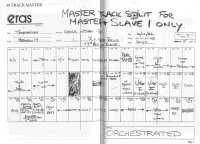 |
fig2 + 3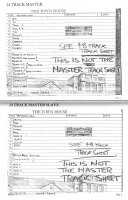 |
fig 4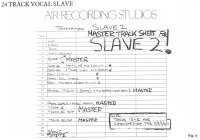 |
fig 5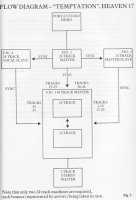 |
